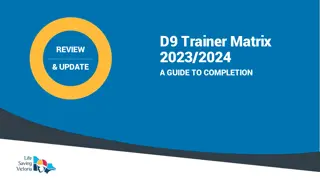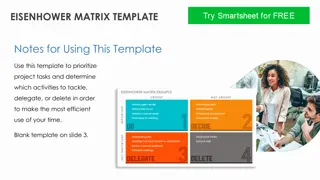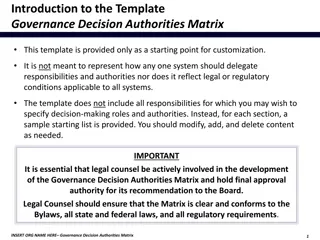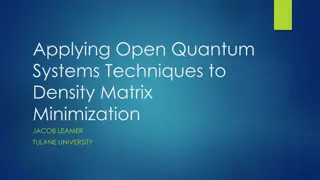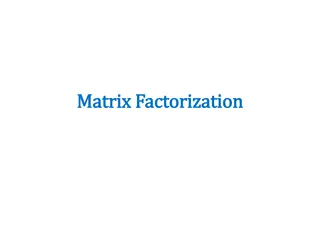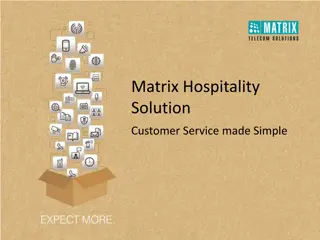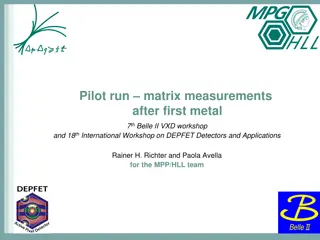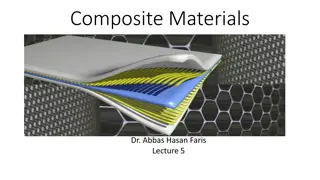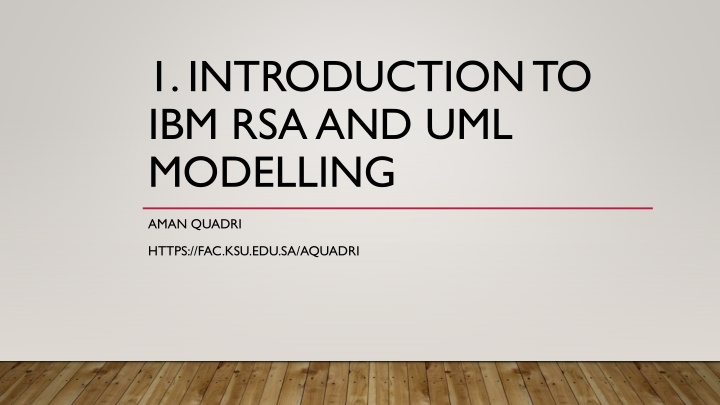
IBM Rational Software Architect Introduction and UML Modelling Overview
Learn about IBM Rational Software Architect (RSA) and UML modelling with Aman Quadri. This overview covers the basics of RSA, workspace management, perspectives, interactive lab environment, and hands-on exercises. Explore the applicability matrix, lab activities, and suggestions for SDLC choices based on real-world scenarios.
Download Presentation

Please find below an Image/Link to download the presentation.
The content on the website is provided AS IS for your information and personal use only. It may not be sold, licensed, or shared on other websites without obtaining consent from the author. If you encounter any issues during the download, it is possible that the publisher has removed the file from their server.
You are allowed to download the files provided on this website for personal or commercial use, subject to the condition that they are used lawfully. All files are the property of their respective owners.
The content on the website is provided AS IS for your information and personal use only. It may not be sold, licensed, or shared on other websites without obtaining consent from the author.
E N D
Presentation Transcript
1. INTRODUCTION TO IBM RSA AND UML MODELLING AMAN QUADRI HTTPS://FAC.KSU.EDU.SA/AQUADRI
IBM RATIONAL SOFTWARE ARCHITECT Introduction & Basic terminology: The IBM Rational Software Delivery Platform is a complete solution for developing software and software- based systems. A workspace is the location where you store your work. Any resources (projects, folders, and files) that you are working on are available in this workspace. A perspective defines a set of editors and views arranged in an initial layout for a particular role or task.
INTERACTIVE LAB ENVIRONMENT Use case Diagram: Start Rational Software Architect if it's not already started: From Windows select Start > Programs > IBM Rational > IBM Rational Software Architect v6.0 > Rational Software Architect. 2. A window appears asking for the workspace directory. Select OK to accept the default. From the workbench, select File > New > Project > Other. 2. Select UML Project and then select Next. 3. Enter MyProject as the project name, and select Next. 4. Enter MyProject UML Model as the file name of the UML Model, uncheck the box Create a default diagram in the new model, then select Finish
IBM RSA HANDS ON Quick lab to familiarize students with RSA through modelling a phone book application
LAB ACTIVITY - 1 Rules: Students must use a paper sheet to answer the questions. No discussion with fellow student is allowed. Students are instructed to mention their ID no s on the top of the sheet.
SUGGEST THE BEST SUITED SDLC - I Contoso Hospital needs a web based software for their outpatient department with the following requirements only: Patient registration Patient health details Doctors notes on history of treatment Appointment and follow-up scheduling What SDLC is best suited for the software?
SUGGEST THE BEST SUITED SDLC - II DMZ Corporation and its child companies need to be interconnected using a ERP software for the chain of products that they manufacture and import, following are the tentative requirements and with due course of time they may increase further Import tracking Manufacturing tracking Communication platform for employees at all levels Inventory management What SDLC is best suited for the software?
SUGGEST THE BEST SUITED SDLC - II Silverhound Logistics Corporation, recently acquired 26 companies and found that all the companies have been using obsolete technologies. Resultantly, it decides to develop an integrated system to connect all its companies to an integrated platform. following are key notes about the project: Although all the requirements for the system have been brainstormed by domain experts yet there is a scope of accommodating new requirements. The development of the system should be completed in 36-48 Months. The development of the modules has to be simultaneous allowing functionality even during the development. In case of critical circumstances modules should be reworked to ensure seamless integration, Implementation and testing of modules should not impede the overall functionality of the Integrated system For the legacy systems of the acquired companies, if any modules can be plugged to the new system with minor changes, the development can go ahead with it What SDLC is best suited for the software?


